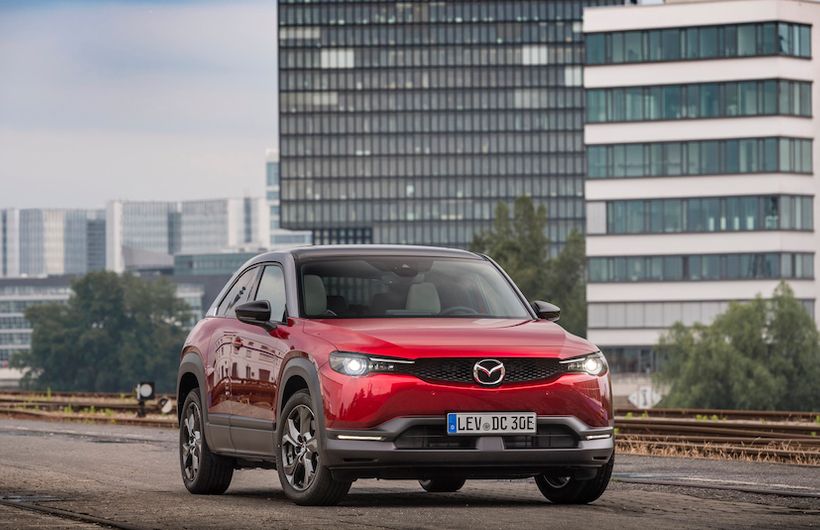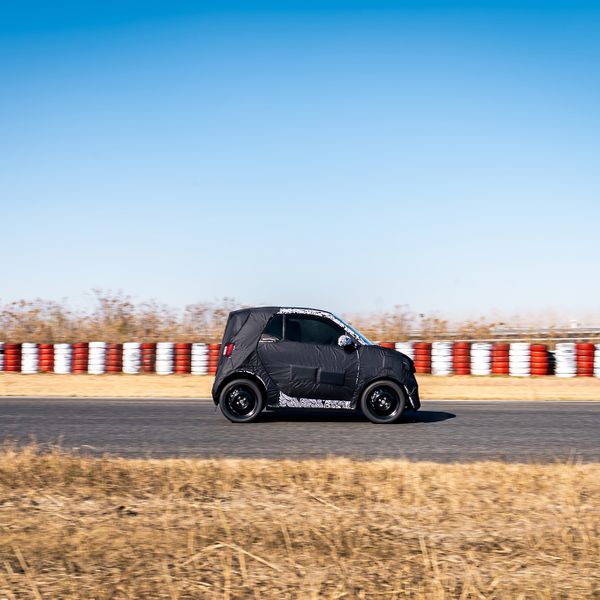Blog: Batteries - enough is enough. Or is it?
Interesting thoughts have been percolating lately, mainly because I’ve just been driving both the Volvo P8 AWD Recharge and the Mazda MX30. Both pure electric EVs, both small SUVs. And yet, that’s pretty much where the similarities end.
The Volvo is a full-house 78kWh bi-motor, all-wheel drive mini-monster with 408bhp, and costs - in the ‘first edition’ format, at least - just under sixty thousand quid. The Mazda, on the other hand, has a 35.5kWh battery pack, a single motor driving the front wheels, 141bhp and, in its cheapest version, can be had for £25,545.
I know, I know, the Volvo has absolutely every item of extra possible loaded into it, and then a few more that you never knew existed, never mind thought you needed, but there is a situation that it throws up. When is enough, enough?
![Red Mazda CX30 front parked]() Mazda MX-30: small battery, small price
Mazda MX-30: small battery, small price Again, we’re talking broadly - after all, there’s a great big swathe of apples vs oranges in play here, and I’m not being glib about a more expensive car offering a better, more luxurious and convenient deal. But where Volvo knows that its market will probably feel they need a range in excess of 240 miles and some firepower kudos, Mazda is gambling on an official range of just 124 miles and acceptable performance. And, as we all know, in winter with the heaters and lights on, that 124-miles may well be more like double figures.
The trick, according to Mazda, is ‘right-sizing’. Quite simply, using the most appropriate powertrain option for the things you want to do. So where a 408bhp small Volvo SUV that can hit 62mph in under five seconds, bluntly, is brilliant fun, it’s probably not the most efficient way of going from point A to destination B. Much side-eye therefore given to every supercar, ever.
But put it like this. Range anxiety is a real thing. More range, more ease-of-use and less charging is more convenient. But you wouldn’t buy a city car and then insist on long-range fuel tanks. It would be heavier, less nimble, less efficient - and you’re sacrificing all of that for the convenience of not visiting a fuel station. Which is what you’re doing when you insist that an electric car has a range you don’t - in most cases - need.
![Volvo XC40 Recharge]() Volvo XC40 Recharge - big range, £60k price tag
Volvo XC40 Recharge - big range, £60k price tag Now obviously there are swathes of the population for whom a car that manages 124miles on a charge isn’t going to work. People who do that sort of mileage in one hit, and for whom adding ‘a few hours’ of charging time onto a day is simply preposterous. But we seem to kid ourselves as to what we need to do with our cars. Need to drive to Aberdeen from London once a year? Cool - rent a traditional car. You’ll be able to with the money you save on fuel if you run an EV for the 11-and-a-half months you spend commuting 20 miles to and from the office. Possibly not, given the current situation, but you get my meaning - the trips to town and supermarket, the visits, the days out.
The Mazda is the car that probably deals with 75-percent of 75-percent of most people’s weekly usage. The problem is that we’re used to buying one car that can conceivably cover everything we need to do in one hit. And while £25k isn’t cheap-cheap, it’s showing that stuffing heavy and expensive batteries into cars to satisfy a slightly hollow need might not be the way forward.
I’ve been looking at the way I use a car a lot over the past year. How I consume transportation. I’m outside the curve for ‘normal’ use, regularly making random big trips to rural places and doing odd things where charging definitely would be an issue, no matter how well planned. But for the 75-percent of the rest of the time, a pure EV would deal with everything I need to do without fuss. And that EV wouldn’t need a huge amount of range. For instance, my longest regular journey outside of work is to my in-laws 52 miles away. Just about do-able there and back in the MX-30.
![BMW X5 xDrive45e]() PHEVs with a range of 50+ miles start being useful
PHEVs with a range of 50+ miles start being useful Personally, I’d like a bit more squish in the numbers than that (I’m the guy that fills up his car at a quarter tank ‘to be safe’), so have in my head that anything upwards of 200 miles of usable, real-world guaranteed range is where I’d be happy. Similarly, once PHEVs start hitting 50-miles of actual electric running, they start to be more than just CO2-tweaking tax dodges - and something like that would effectively remove the need for a second option; we’d be back to the one-car-does-it-all scenario, at least until we figure out what is genuinely the best option for personal mobility.
Have we got it all sorted? No, of course not. But things are changing. It’s one of the most fascinating times in the car industry for the last 100 years.
![Ford Kuga ST Line X Eco Blue PHEV4]() Things are changing, says Tom. It’s a fascinating time in the industry.
Things are changing, says Tom. It’s a fascinating time in the industry.  Mazda MX-30: small battery, small price
Mazda MX-30: small battery, small price 













